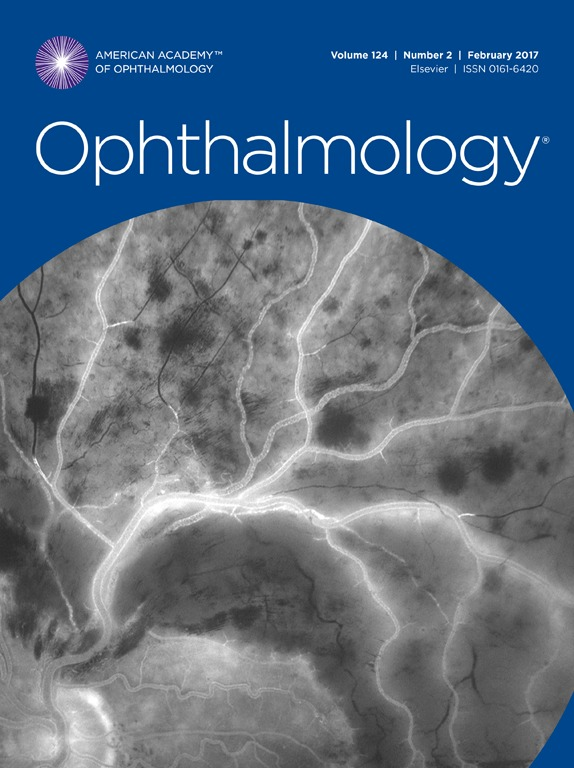评估轴长不对称患者的青光眼严重程度和进展情况:一项患者内部比较研究。
IF 13.1
1区 医学
Q1 OPHTHALMOLOGY
引用次数: 0
摘要
设计:长期观察研究 参与者:2010 年至 2020 年期间在韩国首尔国立大学医院确诊为青光眼的 20 岁以上患者:2010年至2020年期间在韩国首尔国立大学医院确诊为青光眼的20岁以上患者:方法:纳入确诊为双眼青光眼且眼轴长度相差超过 1.0 毫米的患者。将每个人的眼睛分为 "长眼 "和 "短眼",并使用配对检验分析基线和随访临床数据:主要结果指标:轴长度不对称患者临床特征的差异 结果:研究共纳入 95 名轴长度不对称青光眼患者的 190 只眼睛。患者的平均年龄为(51.2 ± 12.3)岁,平均随访时间为(10.1 ± 3.9)年。长眼和短眼的基线眼压(IOP)和中央角膜厚度(CCT)没有差异。在基线眼盘参数中,长眼的椭圆度指数、β区和γ区毛乳头旁萎缩(PPA)面积较大。在基线 OCT 数据中,长眼睛的视网膜神经纤维层(RNFL)厚度和神经节细胞内丛状层(GCIPL)厚度较薄。根据基线视野(VF)测试,长眼睛的平均偏差(MD)和视野指数(VFI)值明显较低。根据对青光眼进展的分析,长眼者的上部 GCIPL(长眼:-0.65 μm/年,短眼:-0.40 μm/年)、MD(长眼:-0.40 dB/年,短眼:-0.21 dB/年)和 VFI(长眼:-0.92 %/年,短眼:-0.46 %/年)的变化率更大。两眼间平均眼压和β区PPA面积的差异越大,RNFL和GCIPL的变化率差异也越大。此外,眼压波动差异越大,MD 和 VFI 的变化率差异也越大:结论:当两眼轴长相差超过 1.0 毫米时,长眼的青光眼程度更严重,进展更快。青光眼进展速度的眼间差异与平均眼压和眼压波动有关。本文章由计算机程序翻译,如有差异,请以英文原文为准。
Assessing Glaucoma Severity and Progression in Individuals with Asymmetric Axial Length
Purpose
To investigate whether a difference exists in intereye glaucoma severity and progression in patients with asymmetric axial length.
Design
Long-term observational study.
Participants
Patients older than 20 years with a diagnosis of glaucoma at Seoul National University Hospital, Seoul, Korea, between 2010 and 2020.
Methods
Patients with a diagnosis of glaucoma in both eyes with an axial length difference of more than 1.0 mm were included. Each individual’s eyes were classified into longer eye and shorter eye, and the baseline and follow-up clinical data were analyzed using the paired T-test and McNemar test.
Main Outcome Measures
Differences in clinical characteristics in patients with asymmetric axial length.
Results
A total of 190 eyes of 95 patients with glaucoma with asymmetric axial length were included in the study. The patients’ mean age was 51.2 ± 12.3 years, and the mean follow-up period was 10.1 ± 3.9 years. No difference was found in baseline intraocular pressure (IOP) or central corneal thickness between longer eyes and shorter eyes. Among the baseline disc parameters, ovality index, β-zone and γ-zone parapapillary atrophy (PPA) area were larger (P < 0.001) in the longer eyes. In the baseline OCT data, the retinal nerve fiber layer (RNFL) thickness (P = 0.009) and ganglion cell–inner plexiform layer (GCIPL) thickness (P < 0.001) were thinner in the longer eyes. According to a baseline visual field (VF) test, the mean deviation and VF index (VFI) values were significantly lower (P < 0.001, P = 0.034) in the longer eyes. Based on an analysis of glaucoma progression, the rate of change of superior GCIPL (longer eyes, –0.65 μm/year; shorter eyes, –0.40 μm/year), mean deviation (longer eyes, –0.40 dB/year; shorter eyes, –0.21 dB/year), and VFI (longer eyes, –0.92%/year; shorter eyes, –0.46%/year) were larger (P = 0.006, P = 0.005, P < 0.001) in the longer eyes. Additionally, the greater the difference in IOP fluctuation, the greater the difference in the rate of change between mean deviation and VFI.
Conclusions
When an axial length difference of more than 1.0 mm was present, glaucoma tended to be more severe and to progress faster in the longer eyes.
Financial Disclosure(s)
The author(s) have no proprietary or commercial interest in any materials discussed in this article.
求助全文
通过发布文献求助,成功后即可免费获取论文全文。
去求助
来源期刊

Ophthalmology
医学-眼科学
CiteScore
22.30
自引率
3.60%
发文量
412
审稿时长
18 days
期刊介绍:
The journal Ophthalmology, from the American Academy of Ophthalmology, contributes to society by publishing research in clinical and basic science related to vision.It upholds excellence through unbiased peer-review, fostering innovation, promoting discovery, and encouraging lifelong learning.
 求助内容:
求助内容: 应助结果提醒方式:
应助结果提醒方式:


